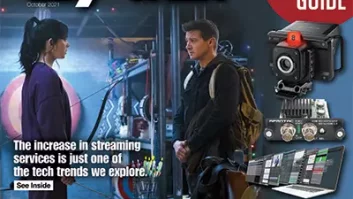The broadcast industry will assemble in Las Vegas seeking guidance on how to navigate an industry in flux. From the continued growth of OTT and VoD services, the shift towards IP, and the increasing number of non-traditional players in the market, the industry is transforming at a dizzying pace.
For traditional broadcasters, there is the question of how to evolve channel offerings in the face of competition from digital disruptors like Amazon and Netflix. Meanwhile, newer rights holders – which includes Apple after its launch of Apple TV+ last month – face the challenge of securing growth in this fiercely competitive landscape.
This year’s NAB will see content owners battling to understand the latest solutions for keeping ahead of the curve in 2019.
Monetising content
According to Ofcom’s latest Communications Market Report, the opportunity for audiences to engage with TV content in all its forms is growing exponentially. Smartphones have become the most popular internet-connected device, with 78 per cent of adults using them, whilst 58 per cent of UK households own tablets and 42 per cent own smart TVs, up from 5 per cent in 2012.
Given the changing media consumption patterns and the amount of choice on offer, competition for eyeballs is intense. Rights holders must now battle for viewership across multiple screens, platforms and locations in order to get the biggest returns on their content, and there is also the question of how to engage audiences via social media and other digital platforms.
Broadcasters are suddenly working higher up the value chain to find the most lucrative monetisation model available to them. From whether to deliver on-demand or linear streaming services, to distributing content direct-to-consumer or via third parties, there are a number of challenges the industry is looking to overcome at NAB this year.
A flexible approach
Exploring these new ways of monetising content isn’t without risk, and as a result many broadcasters are demanding flexible commercial models that allow them to instantly adapt to market changes in order to pursue new avenues in a ‘test-bed’ environment. Content owners need the flexibility to rollout new channels quickly and affordably in response to changing consumer behaviour, and then have the scalability to pull them down when those habits shift.
By taking content storage and distribution into the Cloud, virtualisation services save broadcasters from needing to deploy dedicated equipment to perform individual tasks. Removing these expensive hardware dependencies will yield significant cost savings at a time where broadcasters want to redistribute budget into content. What’s more, the ability to support a new programme rollout or scale down instantly, means that there is no longer a need to invest in additional hardware for peak hours that will simply sit idle during slower times.
For broadcasters, there is the challenge of finding a commercial model that offers the desired level of flexibility, on a platform that is resolute and reliable. At NAB, broadcasters will explore future Cloud-based systems for media distribution that are provided as a service offering, giving them management control and ongoing support in evolving the proposition.
Applying insights
As rights holders compete to get ahead of these new technologies and monetisation strategies at NAB, we can expect varying stories of success and struggle over the coming year. However, the tools for analysing and reacting to the market are becoming much more accessible and there is now more information than ever to help broadcasters to build the necessary understanding of their audiences.
By applying data analytics and AI technologies broadcasters can gain real-time insights into how well a channel or programme is performing in different geographies, and make informed decisions on where to invest. It can also help them build a deeper understanding around the expectations of their customers, allowing them to adapt content to their particular needs, and even provide tailored services.
The use of technology can answer some of the key questions for driving successful content, including what viewers want to watch, what time they want to watch it, and what devices they use. For many, NAB has become the place to discover these innovations.
The NAB Show has been the centre of industry discussion and debate for over three decades, but the last five years have arguably seen the biggest changes in terms of disrupting technologies and viewing habits. And it shows no signs of slowing in years to come – new service offerings will continue to come to market, the IP proposition will evolve, and OTT services will change the habits and expectations of viewers.
Broadcasters attend NAB concerned with how they can keep pace and implement models to respond to consumer demand, and Cloud virtualisation will be crucial in helping content owners test new services and take advantage of new technologies.







